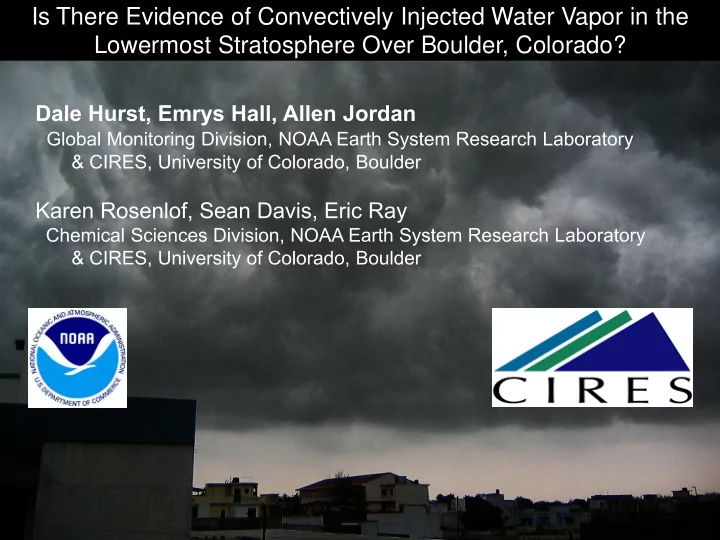

Is There Evidence of Convectively Injected Water Vapor in the Lowermost Stratosphere Over Boulder, Colorado?
Transport of Water Vapor: Tropical Source Temperature Lower Stratosphere Very Dry Θ =380K “Overworld” (<5 ppm) 16 km Stratosphere Ice Mixed Lowermost Stratosphere Θ =360K “Middleworld” (<20 ppm) Liquid Ice? Liquid Water Tropopause Θ =310K 8 km Vapor Vapor Vapor Upper Troposphere Very Wet Weak Convection Strong Convection “Underworld” Troposphere (10,000+ ppm) Pole Tropics Latitude
Transport of Water Vapor: Mid-Latitude Source Lower Stratosphere “Overworld” Θ =380K 16 km Ice Lowermost Stratosphere Θ =360K “Middleworld” Liquid Ice? Liquid 8 km Θ =310K Vapor Vapor Upper Troposphere Strong Convection Weak Convection “Underworld” Pole Tropics Latitude
The Big Questions Global Perspective Is convection an important source of stratospheric water vapor? What is the impact of convectively-sourced WV on the radiation budget and climate? North American Mid-Latitude Convection Studies Anderson et al . (2012) measured 10-18 ppm WV in the LS over the south-central USA during summertime and postulated that frequent and widespread convective injection of WV into the overworld could cause significant ozone losses over populated areas. Schwartz et al . (2013): 8 years of MLS data in the LS (100 hPa) over the North American monsoon region (July, August) showed WV >8 ppm only 2.5% of the time. Are MLS measurements with 3-km vertical resolution able to detect potentially thin wet layers deposited in the LS by convective overshooting? Homeyer et al . (2014) linked 60-225 ppm WV in the lowermost stratospheric middleworld over the south-central USA in May 2012 to mesoscale convective systems, with some evidence of convective injection into the overworld. • Does convection frequently reach the lower stratospheric “overworld” with potential implications for stratospheric ozone? • or does convection predominantly reach only the lowermost stratospheric “middleworld”?
NOAA Frost Point Hygrometer (FPH) • Monthly FPH soundings at Boulder since 1980 (N=404) • Vertical Resolution of 5-10 m from surface to ~26 km. 250-m averages used here. • FPH measures stratospheric WV with an accuracy of ±10% (±0.5 ppm in LS) H 2 O (ppm)
Tropopause Dynamics over Boulder (40°N, 105°W) Lapse Rate Tropopauses (WMO definitions) determined from Radiosonde Temperature Profiles Summer TP tr • TP tr Altitude (km) TP ex • TP ex TP tr Winter Altitude (km) TP ex Convective Months (MJJAS) N=168 -TP tr present for 88% of flights -Double TP: 41% Winter Months (DJF) N=92 Latitude (°N) - TP ex present for 100% of flights - Double TP: 84% adapted from Kunz et al . (2013)
Detecting Anomalously High WV Above Boulder Monthly Mean Vertical Profiles over Boulder 1980-2014 5.5% (N=8) Convective Months (168 flights) TP tr TP ex 15.6% (N=14) Water Vapor (ppm)
Convective Influence above TP ex ? 10-day back trajectories: 1 hr steps, 100 m resolution TP tr 14-16 km Good potential for TP ex convective influence
Convective Influence above TP ex and TP tr ? 10-day back trajectories: 1 hr steps, 100 m resolution TP tr TP ex High potential for convective influence
Findings from Boulder FPH Profiles (May-Sep) • WV > 12 ppm above TP ex for 14 FPH flights (~15% of flights with TP ex ) • WV > 8 ppm above TP tr for 8 FPH flights (~5% of flights with TP tr ) • 10-day back trajectories indicate possible convective influence for 5 of 21 flights with anomalously high WV in the stratosphere This analysis suggests (for Boulder) • Some evidence of convective influence in the “middleworld”, but high WV is mostly due to northward flow of tropical air through TP break • Infrequent evidence of convective influence in the “overworld” Caveats 1. Boulder too close to Rockies to sample mesoscale convective systems 2. 10:00 FPH launches at Boulder do not target local convection 3. No IWC measurements but RHi << 100% when WV is anomalously high Suggested Improvement 1. Move Boulder to the east or the Rocky Mountains to the west
MLS WV at Boulder (40°N, 105°W) and (40°N, 95°W) MLS retrievals for May-September: ±2° latitude, ±2° longitude 1.2% 0.2% 11.7% 5.9%
Summary and Conclusions Observations of High WV during May-Sep (2004-2014) Instrument Site Above Freq Above Freq FPH Boulder TP ex 15.6% TP tr 5.5% MLS Boulder 147 hPa 5.9% 100 hPa 0.2% MLS 40°N, 95°W 147 hPa 11.7% 100 hPa 1.2% • Over these two locations, anomalously high WV is observed much more frequently in the middleworld than in the overworld. • Convective influences are observed < 6% of the time in the overworld above Boulder and 10° east of Boulder. • Only 25% of the high WV observations over Boulder are linked (by back trajectories) to the N. American monsoon region. • The stratospheric layers of high WV over Boulder may be too thin to be detected as anomalously “wet” by MLS retrievals with 3 km vertical resolution.
Recommend
More recommend